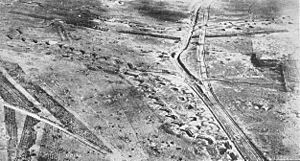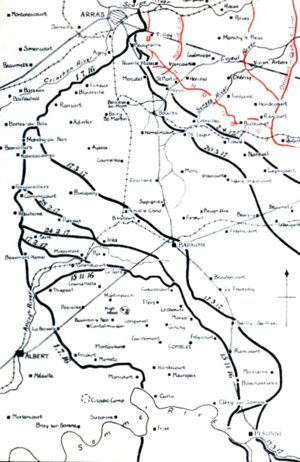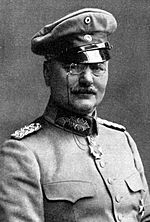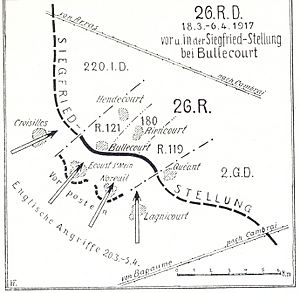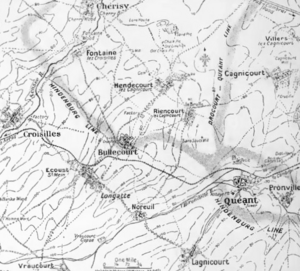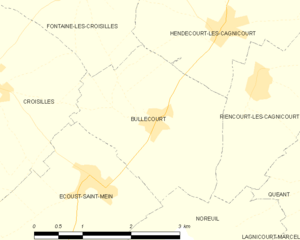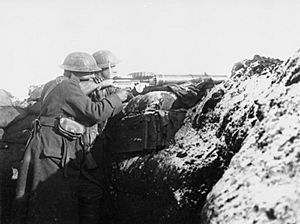German attack on Lagnicourt facts for kids
Quick facts for kids German attack on Lagnicourt (Unternehmen Sturmbock [Operation Battering Ram]) |
|||||||
|---|---|---|---|---|---|---|---|
| Part of Flanking Operations to the Arras Offensive; Round Bullecourt (11 April – 16 June) Western Front of the First World War | |||||||
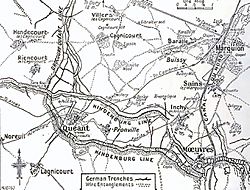 Hindenburg and Drocourt-Queant Lines (1918) |
|||||||
|
|||||||
| Belligerents | |||||||
| Commanders and leaders | |||||||
| Paul von Hindenburg Crown Prince Rupprecht |
Douglas Haig Hubert Gough |
||||||
| Strength | |||||||
| 4 divisions (16,000 infantry) |
3 divisions (4,000 infantry) |
||||||
| Casualties and losses | |||||||
| 2,313 | 1,010 | ||||||
The German attack on Lagnicourt (also known as Unternehmen Sturmbock, meaning "Operation Battering Ram") happened on 15 April 1917. It was a military operation during the First World War on the Western Front. Four German army groups launched a surprise attack against the 1st Anzac Corps of the British Fifth Army.
The main goals of this German attack were to slow down the British Fifth Army's advance towards the Hindenburg Line, cause damage, and destroy as much enemy equipment as possible, especially their artillery. The Germans also wanted to protect their own troops fighting in the Battle of Arras and to show that their morale was still high, even after they had moved back to the Hindenburg Line. The British Fifth Army was getting ready for a bigger attack called the Battle of Bullecourt (3–17 May 1917).
The German attack hit the positions of the 1st Australian Division and the 2nd Australian Division. The Australians managed to push back most of the attacks. However, at Lagnicourt, German soldiers broke through, captured some prisoners, destroyed six artillery guns, and took important secret documents. Australian counter-attacks then cut off some of the German attackers. The Germans suffered about 2,313 casualties, while the Australians had 1,010.
After the attack, the British Fifth Army quickly brought up more artillery and made their defenses stronger. They continued to prepare for the next attack at Bullecourt. German commanders later criticized the attack because it was rushed, didn't achieve much, and caused many casualties. The British did not move any of their reserve troops from the area and continued their offensive at Arras.
Contents
Background to the Attack
The Hindenburg Line
In 1916, General Erich von Falkenhayn, who was the head of the German General Staff, was replaced by Field Marshal Paul von Hindenburg and General Erich Ludendorff. This new leadership decided to stop the fighting at Verdun on the Western Front. They asked for ideas to create a new, shorter defensive line in France. Crown Prince Rupprecht, who led a German army group, was told to prepare this new line. This new defense was called the Hindenburg Line (or Siegfriedstellung).
The Hindenburg Line was built to shorten the Western Front. This would allow Germany to use fewer soldiers there and create reserve troops for other battles. The line was a very strong set of fortifications.
Operation Alberich
In early 1917, the Germans began a planned withdrawal to the Hindenburg Line. This operation was called Alberich Bewegung (Alberich Manoeuvre). On 17 March, the German armies started to pull back from about 110 miles (177 km) of their old front line. They destroyed bridges, roads, and created large flooded areas to make it harder for the British to follow them.
By 18 March, most German troops had reached the Hindenburg Line. However, some parts of the line were still being improved. So, German outposts in villages close to the Hindenburg Line had to hold on longer than planned. This meant they were still fighting the British as they tried to reach the new German defenses.
German Army Groups
During the Battle of the Somme in 1916, army divisions became tired very quickly. By 1917, the way German corps (large army units) were organized had changed. After the retreat to the Hindenburg Line, the IX Reserve Corps became known as Gruppe Arras. The XIV Reserve Corps, led by Generalleutnant Otto von Moser, became Gruppe Quéant. This group held a part of the Hindenburg Line that was about 11,000 yards (10 km) long.
The German 6th Army headquarters thought this section of the line was too weak to be held by just two divisions. So, on 13 April, the 3rd Guard Division was sent to Gruppe Quéant. This division had been resting and training for three months.
Preparing for the Attack
British Fifth Army Plans
The British Fifth Army had originally planned to attack alongside the Third Army. But the German withdrawal to the Hindenburg Line changed everything. The Fifth Army was then ordered to push back the German rearguards and prepare to attack the Hindenburg Line itself. This was a much harder job.
The Fifth Army had fewer divisions and artillery guns. Also, bringing up supplies was slow because the Germans had destroyed many roads. The Hindenburg Line was much stronger than the old defenses. If the Fifth Army could break through it, it would help the Third Army's attack.
The British commander, General Gough, suggested that the Fifth Army could help the main attack. But because they didn't have enough resources, they could only attack on a small front. They chose to attack at Bullecourt. This village was about 3.5 miles (5.6 km) from a key road.
On 2 April, the Fifth Army captured some German outpost villages. General Gough then ordered his troops to take risks to bring up as much heavy artillery as possible. On 5 April, he ordered an attack on a 3,500-yard (3.2 km) front with Bullecourt in the middle. The British received some tanks to help with the attack. However, heavy guns were delayed by German road destruction.
First Attack on Bullecourt
The Hindenburg Line defenses around Bullecourt formed a "re-entrant" (a part of the line that curves inward). This area was defended by the strong German 27th Division. On 8 April, the British realized that cutting through the German wire defenses would take another eight days.
On the evening of 9 April, patrols found that the Hindenburg Line was occupied. But the artillery had made some paths through the wire. The 4th Australian Division was to attack with two brigades. The attack had to cover 500 yards (457 m) to the wire and another 100 yards (91 m) to the first trench. The attack was planned for 4:30 a.m. to avoid heavy crossfire.
At 1:00 a.m., Bullecourt was hit with gas shells. Six Australian battalions gathered in no man's land, waiting for tanks. But the tanks were late. The attack was delayed, and the infantry had to go back to cover.
The Attack on 11 April
On 11 April, it was decided that the infantry would advance 15 minutes after the tanks. Only four tanks reached their starting line by 4:30 a.m. The tanks were heard by the Germans, who were ready. Some tanks had mechanical problems or were knocked out by German machine guns.
The Australian infantry who made it into the German defenses were cut off. They ran out of grenades and were forced back. Many were captured or suffered heavy losses while trying to retreat. German artillery also fired on the Australian-occupied trenches, making them impossible to hold. By noon, the German counter-attack had succeeded. Few Australians managed to get back across no man's land.
The German Plan for Lagnicourt
After the British attack on 11 April, the area around Bullecourt was quiet. The German XIV Reserve Corps noticed that the 1st Australian Division had taken over part of the front line. Major Friedrich von Miaskowski, a German staff officer, suggested attacking while the Australian and British troops were still disorganized.
On 13 April, General Moser asked for permission to use the 3rd Guard Division and the 2nd Guard Reserve Division for a surprise attack. This attack would cover about 4 km (2.5 miles) from Lagnicourt south to Hermies. The German high command approved the plan and added two more divisions.
The plan for "Operation Battering Ram" was issued on 14 April for an attack at 4:00 a.m. on 15 April. The goal was to stop the British from getting too close to the main Hindenburg Line defenses. It also aimed to cause many casualties and destroy equipment, especially artillery. The attack was also meant to show that the Germans were still strong.
The Attack on 15 April
The German attack involved four divisions, each with specific targets.
4th Ersatz Division Attack
The 4th Ersatz Division attacked with four battalions. Their advance immediately ran into problems. German artillery fired too short, hitting their own troops. Australian outposts were also much further forward than the Germans expected. Australian rifle and machine-gun fire stopped the German advance. By 3:00 p.m., the attacking troops were ordered to retreat. They managed to take eleven Australian prisoners.
38th Division Attack
Five battalions from the 38th Division attacked from the village of Mœuvres. Australian fire caused the attacking waves to merge, and the third wave suffered many casualties. Some German troops claimed to have entered parts of Demicourt and Boursies. However, news arrived that the attacks on their flanks had been stopped with heavy losses. The division retreated at 8:00 p.m., claiming to have taken 147 prisoners.
3rd Guard Division Attack
The 3rd Guard Division attacked with three battalions on the right and three on the left. They were on unfamiliar ground and had no time to scout. On the left, they surprised some Australian posts but then ran into hidden machine-gun nests. These were costly to attack, and even with reinforcements, the advance stopped. On the right, the attack was also stopped by Australian troops. Some German troops did get into Lagnicourt with another division.
2nd Guard Reserve Division Attack
The soldiers of the 2nd Guard Reserve Division knew the area well. Their commander decided not to have a long artillery bombardment before the attack. This was to allow the attackers to reach the Australian artillery positions before the alarm was raised. This silent approach worked. By 3:25 a.m., they reported only light machine-gun fire.
At 3:50 a.m., they reported capturing a key ridge with few losses. By 4:00 a.m., they occupied Lagnicourt. They were surprised to overrun Australian artillery guns in the Lagnicourt valley. These guns were thought to be much further away. Around 6:00 a.m., Australian artillery began firing on the German troops. This fire was directed by a British aircraft flying very low.
The increasing artillery fire stopped the German advance by 7:15 a.m. The regiment in Lagnicourt was ordered to recapture the spur. But the commanders decided to withdraw. The German troops moved back under heavy fire. By 11:50 a.m., they were back in their original positions. The division claimed to have destroyed 22 guns, damaged 11, and taken 283 prisoners. They also found important documents showing where the 1st Australian Division was positioned.
1st Australian Division Defense
At 4:05 a.m., a sentry alerted an Australian post, which opened fire and pushed back the 4th Ersatz Division. However, other posts along a 1,000-yard (914 m) front were attacked. The Germans were visible in the light of their flares and were shot down or forced to retreat. The 4th Australian Battalion also pushed back attacks but lost a post to a flame-thrower attack. Counter-attacks failed, but the Australians held on in Boursies.
The attack on the 3rd Australian Brigade began with a sudden bombardment at 4:00 a.m. The 11th Australian Battalion pushed back a frontal attack. But German troops advanced along a gully and attacked the posts one by one from the front and behind. The Australian soldiers fought hard, giving time for reinforcements to form a new line. The 12th Australian Battalion was attacked later and easily pushed back the Germans. However, many German troops were seen south of Lagnicourt. Parts of the 12th and 17th Australian Battalions were overrun without warning. German infantry rushed into Lagnicourt.
2nd Australian Division Defense
Only the 17th Australian Battalion of the 2nd Australian Division was involved in the attack. They were pushed back to the Bullecourt–Lagnicourt road. The German infantry captured four batteries of Australian field artillery at Lagnicourt and three more further west. Other batteries were also in danger.
Two companies of the 12th Australian Battalion held a sunken road south of Lagnicourt. They fought bravely against attacks from both north and south. By 6:20 a.m., Australian artillery began firing on Lagnicourt and Noreuil. The heavy guns of the 1st Anzac Corps continued to fire, even though they were in danger of being captured. Australian resistance stopped the Germans from moving out of Lagnicourt to the south or southeast.
The 19th Australian Battalion at Noreuil arrived just in time to stop an attack from Lagnicourt. The 20th Australian Battalion advanced carefully and reached the Morchies–Noreuil road by 7:00 a.m. As soon as it was light, the Germans in the Lagnicourt area came under fire from three sides. Many German troops surrendered, and others were shot while retreating. Lagnicourt was quickly recaptured. Only five field guns and one howitzer had been destroyed. The Germans had occupied the village for about two hours.
Aftermath of the Battle
Casualties
The German attack on Lagnicourt was a costly battle for both sides. According to Australian records, the German attackers suffered about 2,313 casualties. This included 829 from the 2nd Guard Reserve Division, 545 from the 3rd Guard Division, 519 from the 38th Division, and 420 from the 4th Ersatz Division. The Australians took 362 German prisoners.
The 1st Anzac Corps, which included the Australian troops, suffered 1,010 casualties. Of these, 646 were from the 1st Australian Division and 364 from the 2nd Australian Division. At least 300 Australians were taken prisoner by the Germans.
The Germans claimed to have destroyed 22 guns, but the Australians found that only five field guns and one howitzer had actually been destroyed.
What Happened Next
After the attack, the front line remained quiet on 15 April. However, on 16 April, heavy artillery bombardments began again. This suggested that another attack was likely. The Germans moved more troops into the front line to make their defenses stronger. They expected another attack on a line from Bullecourt to Riencourt and Quéant. German artillery also fired back at British assembly areas every morning.


